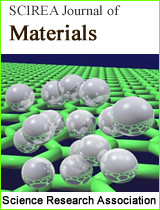On the Melting of Metals
DOI: 10.54647/materials430219 92 Downloads 171462 Views
Author(s)
Abstract
Thermal expansion is related to the atomic vibration amplitude. Owing to the anisotropy in the lattice, the amplitude will vary with the crystallographic direction, causing strain in the lattice. The strain caused by thermal expansion induces a force large enough to initiate plastic deformation of the metal at the beginning of melting. Deformation begins with the gliding of atoms along the gliding direction between two densely packed planes and corresponds to a certain atomic vibration amplitude in that specific direction. Two-dimensional clusters begin to form, and with the input of more energy, melting continues through the formation of three-dimensional clusters and lattice breakage. The heat of fusion corresponds to the energy required to rotate the clusters. When the lattice breaks down, strain energy in the solid is released. This causes a significant decrease in the binding energy between atoms in the liquid state compared to those in the solid state. The volume change during melting is related to changes in the binding energy between atoms in the solid and liquid states. The melting temperature is determined using this theory. The effects of stirring, pressure and gravity on the size of the clusters and melting point are discussed.
Keywords
cluster, heat capacity, heat of fusion, melting, metal, structure, temperature
Cite this paper
Hasse Fredriksson,
On the Melting of Metals
, SCIREA Journal of Materials.
Volume 8, Issue 1, February 2023 | PP. 15-30.
10.54647/materials430219
References
| [ 1 ] | M. Born. (1919) Thermodynamics of Crystals and Melting. J. Chem. Phys: 243. 591–603. |
| [ 2 ] | L. Brillouin (1938) On the thermal dependence of elasticity in Solids. Phys. Rev. 54,916–917. |
| [ 3 ] | A. Cottrell. (1995) An introduction to Metallurgy, The Institute of Materials. 1995. |
| [ 4 ] | J.J.Gilvarry. (1956) Phys.Review.102. 308. |
| [ 5 ] | E. Gruneisen. (1912) Theorie des festen Zustndensenatomiger Elements, Annalen der Physik, 344257–306. |
| [ 6 ] | H. Fredriksson, E. Fredriksson. (2005) A model of liquid metals and its relation to the solidification Process. Material Science & engineering. 413, 455–459. |
| [ 7 ] | H. Fredriksson. (2022) Analysis of the Solidification Process of Metal Alloys Under Microgravity Conditions, Frontiers in Metals and Alloys |
| [ 8 ] | F.A.Lindemann. (1910) Yber die Berechnung molekulaer Eigenfrequenzen. Physikalische Zeitschrift.11, (14), 609–614. |
| [ 9 ] | W. Southerland. (1890) Phil. Mag. 30, 318 |
| [ 10 ] | D.C. Wallace. (1991) Mathematical and Physical Sciences. 433, 631–661. |

